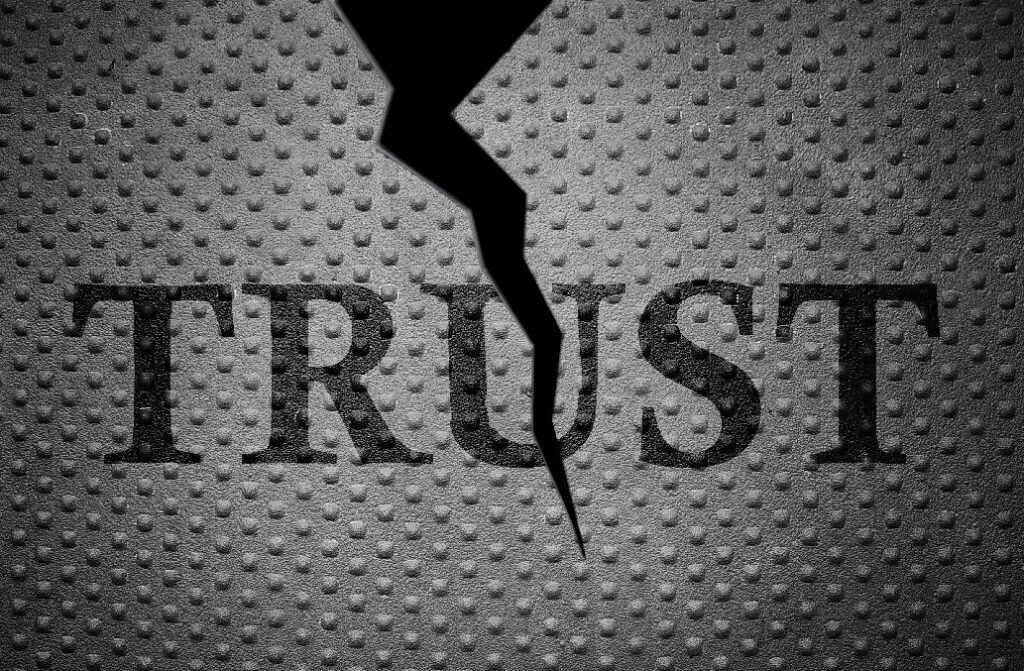Comments
- No comments found

In my 1993 book Technotrends, I said that trust is the glue that holds the net-enabled knowledge economy together.
Admittedly, 1993 was prior to the real boom of the Internet. So why was I able to author a statement like that with such certainty back then?

Simply because without a shred of doubt, it was and still is clear that us living in an increasingly digital and interconnected world is a Hard Trend. As the years started to pass since publishing Technotrends, the prediction became a reality as humankind began making nearly all purchases online and soon after started communicating, collaborating, sharing and reading news, working, and doing just about everything online more than ever.
Based on my Hard Trend Methodology, I knew even then that the only way to keep the integrity of any transaction online was with trust. But as the digital world accelerated far beyond the scope of what many ever imagined it to be, trust has become a complex concept clouded with disinformation, especially for businesses and organizations.
I interviewed David Horsager in one of my latest Opportunity Hour: Conversations with the Masters episodes, and my viewers learned how he teaches business owners, C-Suite executives, and others how to elevate trust both organizationally and personally in a world with increasing levels of disinformation.
David is the CEO of Trust Edge Leadership Institute, and a global authority on helping leaders and organizations become the most trusted in their industry. He is the inventor of the Enterprise Trust Index, director of the annual study titled The Trust Outlook, and a national bestselling author of Trusted Leader: 8 Pillars That Drive Results.
Let me start by highlighting the middle managers, entry-level employees, and general workers at businesses and organizations around the world. Think about how you feel about your employer and receiving a paycheck every week, bi-weekly, or once a month.
Do you feel good about putting trust in your employer? If not, this may be a case of institutional trust issues, and for those business leaders and C-Suite executives reading this blog, this is more common than you might realize.
David Horsager noted that in a recent study, he and his team found that only a staggering 13% of people fully trust their employer!

Institutional trust is down steeply in America. Well before the dawning of the Internet, institutional trust in the United States took a nosedive around the time the Watergate scandal occurred. Suddenly, the roughly 80% of American people who trusted the government to do what was right plummeted down to the roughly 7% that do now!
To compare and connect to the interconnectivity of our world today, the next industry that David’s study found to be the least trustworthy was the media, down to a staggering 2% since the hyper-fast sharing of information on social media. Where it was once “the news” has now developed to be “your news” — a decentralization of facts that make many believe some are fiction.

If that says a lot about powerful institutions like our government or the media, imagine the outlook employees and customers might have on your business or organization when trust is broken! A problem David Horsager finds in much of his team’s research is that we are lacking in regulation and, likewise, there may be an equal connection to too much transparency.
Moving back to the discussion of building trust in and outside of a company, transparency can certainly build trust. Think about when an organization makes a mistake, or, for example, gets hacked and customer and employee data gets leaked. Outside of issuing an apology, being transparent about their mistakes as an organization may not undo what has happened, but it can certainly rebuild trust faster than denial.
Perhaps more conversely, confidentiality is also a trust builder in businesses, organizations, and institutions. There is something to be said for keeping things not as transparent. As I just mentioned above, data breaches in our highly connected world are lethal to the trust that customers and employees build with a company.
The unwilling transparency created by hacking aside, there are other, self-inflicted situations where being too transparent has caused a lack of trust. Imagine working for a business or organization that shares excessive updates on social media regarding a project you are working on. Some may enjoy the attention, while others might get stage fright, so to speak.
Finding a nice balance between transparency and confidentiality is a Hard Trend future certainty in fostering a trustworthy institution of any kind, especially a business or organization.
To find the right path to elevate trust both internally with your employees and externally with customers, David Horsager discusses his highly effective system featuring eight pillars to build trust in his book Trusted Leader: 8 Pillars That Drive Results.
These will be discussed in detail at a later date and how they all connect to an Anticipatory mindset; however, these eight pillars include:
Clarity
Compassion
Character
Competency
Commitment
Connection
Contribution
Consistency
If at any point a breach of trust has occurred at your business or organization, these eight pillars set forth by David Horsager can be used as action steps toward both accountability and anticipation for the future. After reading David’s book to better understand the depth of these trust pillars, measure each one on a scale of 1 to 10 to determine if you are closing in on adequate trustworthiness going forward by simply asking yourself, “How will I do that?”
Essentially, you are conducting what I refer to as a pre-mortem in the process of rebuilding trust. The “how” question posed above is integral, as more often than not, actions taken to rebuild trust or foster a trustworthy culture often point to not what you do, but how you do it.
I will leave you with a couple examples of difficult situations that shake the foundation of trust both internally and externally at a company that David shared with me during his interview.
In one instance, he watched a massive company fire people by simply putting everybody’s name on sheets of paper, almost like grades posted outside of a college lecture hall. Who failed and who got an A, right? All on display for everyone to see.
I would argue that this was too transparent, wouldn’t you?

Especially during the COVID pandemic, layoffs happened all over the world, but how this process was handled either kept internal trust intact at these institutions or fractured it. The CEO of Red Wing Shoes had to face this exact situation, but the way it was handled was much different than posting a pass or fail on the wall of the corporate offices, actually increasing trust even during unprecedented amounts of layoffs!
Your fastest opportunity to build trust is always in crisis, even with customers. Consider the tumultuous BP oil spill from years prior. This affected employees, customers, and even non-customers in being the most catastrophic environmental event caused by an oil company. While they did apologize and made a new commitment to rebuild trust, the actions of cleanup and attempt to rectify the disaster to follow spoke volumes more than a simple “I’m sorry.”
You earn trust through honesty, integrity, and making good on promises. Don’t just think about the present, or in BP’s case, “we need to clean up this mess.” Think of the ideal future, as David Horsager implored during our interview. And I fully endorse this concept, as Anticipatory Leaders looking at pre-solving the problems of the future find significance in thinking of others, not only themselves.
Daniel Burrus is considered one of the world’s leading futurists on global trends and innovation. The New York Times has referred to him as one of the top three business gurus in the highest demand as a speaker. He is a strategic advisor to executives from Fortune 500 companies, helping them to accelerate innovation and results by develop game-changing strategies based on his proven methodologies for capitalizing on technology innovations and their future impact. His client list includes companies such as Microsoft, GE, American Express, Google, Deloitte, Procter & Gamble, Honda, and IBM. He is the author of seven books, including The New York Times and Wall Street Journal best-seller Flash Foresight, and his latest book The Anticipatory Organization. He is a featured writer with millions of monthly readers on the topics of innovation, change and the future and has appeared in Harvard Business Review, Wired, CNBC, and Huffington Post to name a few. He has been the featured subject of several PBS television specials and has appeared on programs such as CNN, Fox Business, and Bloomberg, and is quoted in a variety of publications, including The Wall Street Journal, Financial Times, Fortune, and Forbes. He has founded six businesses, four of which were national leaders in the United States in the first year. He is the CEO of Burrus Research, a research and consulting firm that monitors global advancements in technology driven trends to help clients profit from technological, social and business forces that are converging to create enormous, untapped opportunities. In 1983 he became the first and only futurist to accurately identify the twenty technologies that would become the driving force of business and economic change for decades to come. He also linked exponential computing advances to economic value creation. His specialties are technology-driven trends, strategic innovation, strategic advising and planning, business keynote presentations.
Leave your comments
Post comment as a guest